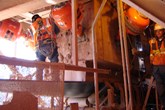Indicated Resources at Finnis Lithium more than double
Published by Claire Cuddihy,
Assistant Editor
Global Mining Review,
Australia-based lithium explorer Core Exploration Ltd (Core) has upgraded its resources at its Grants Lithium Deposit at the Finniss Lithium Project in the Northern Territory which has more than doubled the size of its Indicated Resources and substantially increased the Resource confidence ahead of Feasibility studies to be completed in 2018.
The Grants Lithium Resource comprises 2 million t at 1.5% Li2O and is one of the highest grade spodumene resources in Australia. Over half of the Grants Lithium Resource is now contained in the Indicated category.
According to the company, Core is in the final stages of completing a Pre-Feasibility Study (PFS) for the development of a spodumene concentrate and direct shipping ore operation from the Grants Lithium Deposit and expects to deliver the PFS later this quarter.
Core is working with the NT EPA to finalise the terms of reference for an Environmental Impact Assessment (EIA), following which, the company will prepare and submit a Mining Management Plan (MMP) for the development of the Grants project. Based on the prescribed timeframes for assessment by the NT EPA, Core expects the environmental assessment process to take up to 12 months for the Grants project. Core also expects to complete a full feasibility for the development of spodumene concentrate production from Grants and potentially other future resources within the Finniss Project, such as that at BP33, in 2018 and is planning to complete regulatory approvals and commence production in 2019. A Maiden Resource estimate for BP33 is expected this month. Core will also be re-commencing an aggressive exploration drilling campaign soon with the aim of substantially growing the resource base for the Finniss Lithium Project to underpin a long-life lithium mining and production business.
Dr Graeme McDonald BSc PhD MAusIMM was contracted by Core to undertake the Mineral Resource Estimate for the Grants Lithium Deposit. As part of the preparation of the Resource Estimate, Dr McDonald developed a geological interpretation based on cross sections, generated a 3D geological interpretation from interpreted cross sections, created domain interpretations for lithium, developed a block model of the deposit, undertook a geostatistical analysis of the data and estimated lithium grades.
Dr McDonald’s report notes that fresh pegmatite at Grants is composed of coarse spodumene, quartz, albite, microcline and muscovite (in decreasing order of abundance). Spodumene, a lithium bearing pyroxene (LiAl(SiO3)2), is the predominant lithium bearing phase and displays a diagnostic red-pink UV fluorescence. The pegmatite is not strongly zoned, apart from a thin (1 - 2 m) quartz-mica-albite wall facies. Overall the lithium content throughout the pegmatite is remarkably consistent. Grants has a flat Grade-Tonnage curve at the 1.5% Li2O “sweetspot” for spodumene production. A high 0.75% Li2O cut-off grade results in no significant reduction in the contained tonnes, demonstrating the consistent high-grade nature of the Resource.
The pegmatites are predominantly hosted within the early Proterozoic metasedimentary lithologies of the Burrell Creek Formation and are usually conformable to the regional schistosity. The Bynoe pegmatites are classified as LCT (Lithium-Caesium-Tantalum) type and are believed to have been derived from the ~ 1845 Ma S-Type Two Sisters Granite which outcrops to the west. Fresh pegmatite at Grants is composed of coarse spodumene, quartz, albite, microcline and muscovite (in decreasing order of abundance). Spodumene, a lithium bearing pyroxene (LiAl(SiO3)2), is the predominant lithium bearing phase and displays a diagnostic red-pink UV fluorescence. The pegmatite is not strongly zoned, apart from a thin (1 - 2m) quartz-mica-albite wall facies. Overall the lithium content throughout the pegmatite is remarkably consistent. Drilling techniques and hole spacing The Grants drill hole database used for the MRE contains a total of 54 holes for 6668 of drilling.
Read the article online at: https://www.globalminingreview.com/exploration-development/08052018/indicated-resources-at-finnis-lithium-more-than-double/
You might also like
Martin Engineering’s new Australian Managing Director shares industry insights
Martin Engineering has hired Darren Gilbert as Managing Director of its Australian Business unit and released a Q&A in which he shares some of his industry insights and experience.


